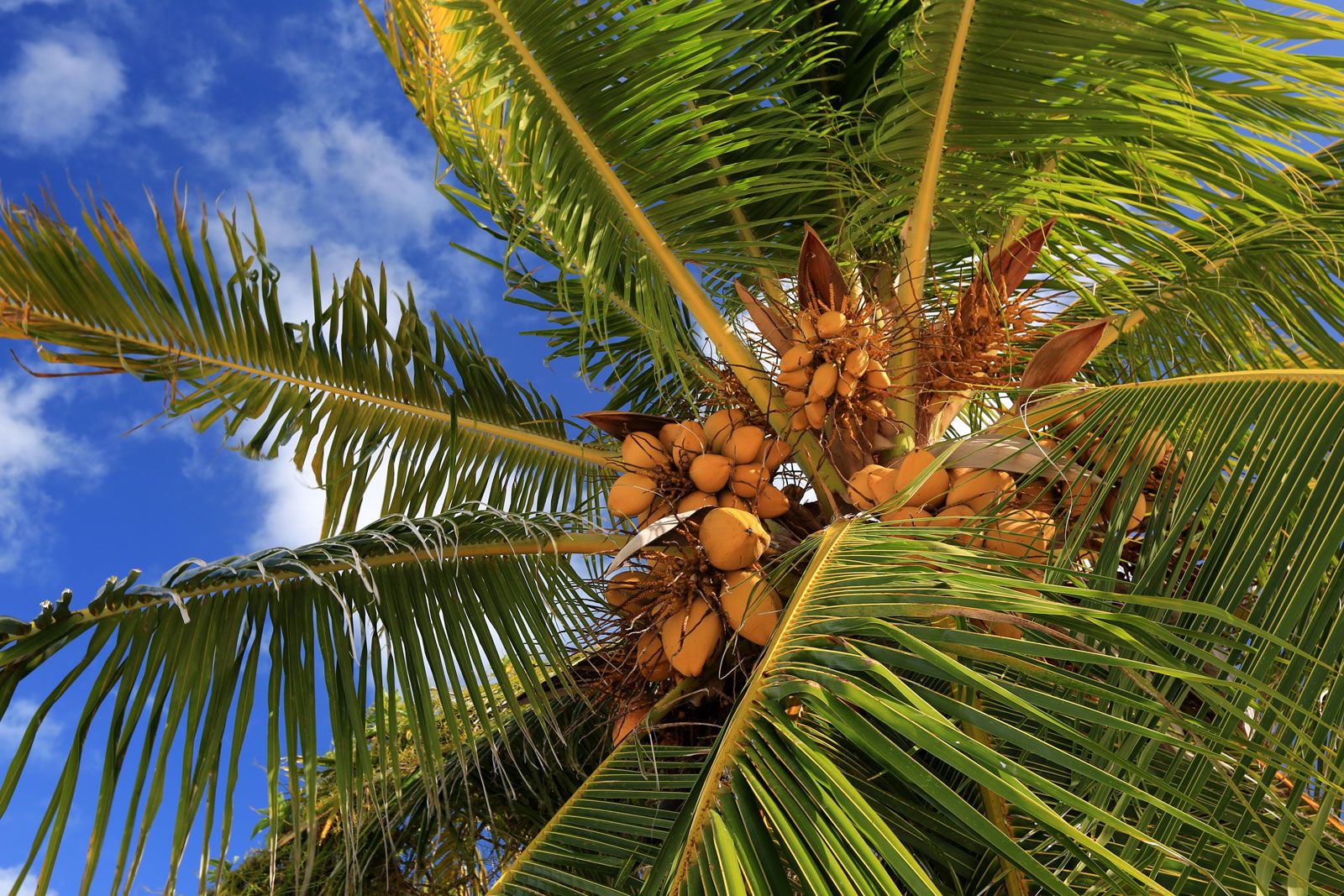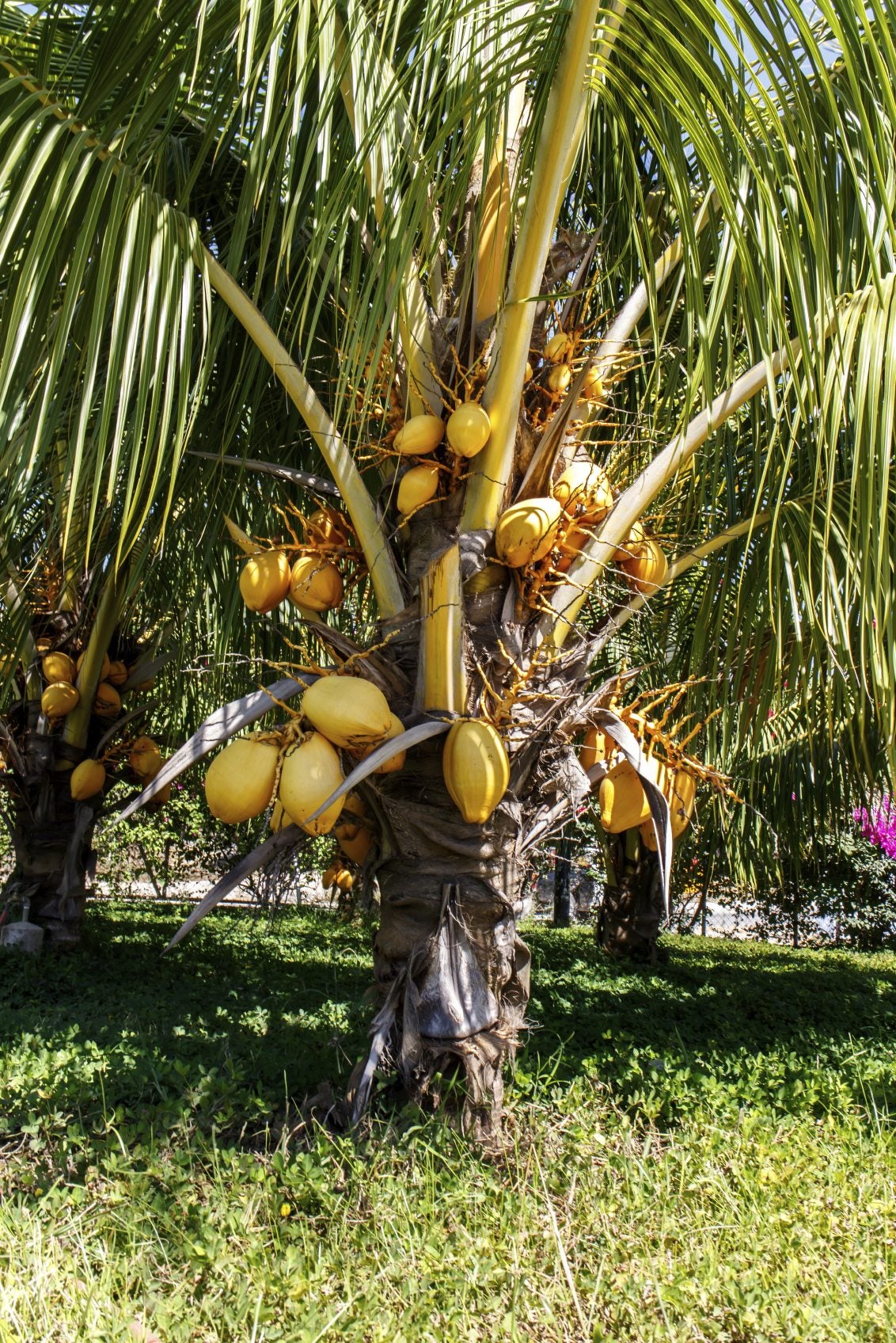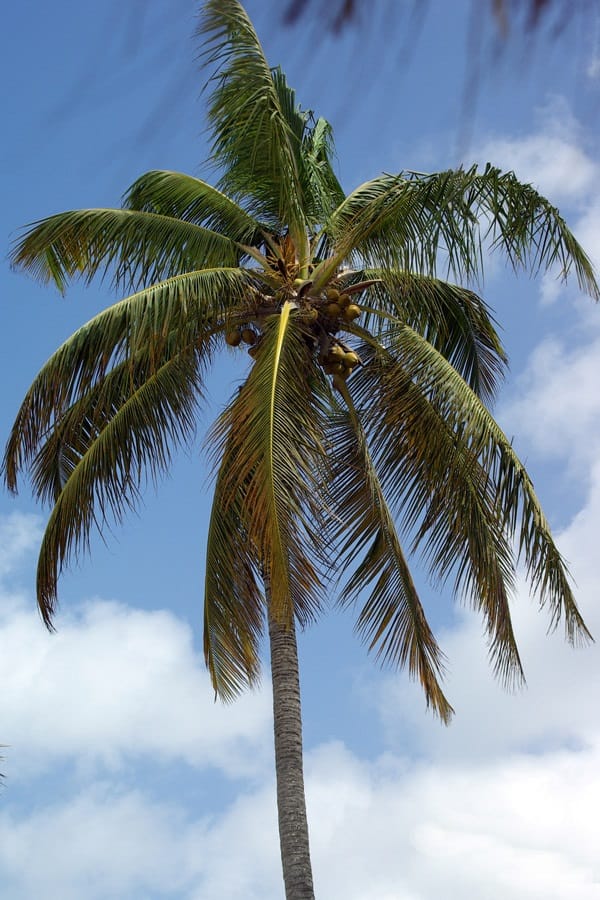Do you understand the distinction between palm trees and coconut trees? Most people aren’t even aware of it, and some individuals aren’t sure what a palm tree is or a coconut tree. The palm tree is not the same as the coconut tree. However, given that the coconut tree is a variety of the palm tree, it is strange for the majority to comprehend how it is feasible. There are many different types of palm trees, but only one produces coconuts. To comprehend this difference, it is necessary to learn about both in-depth. To grasp the distinction, read this article through to the end.
The most noticeable distinction between coconut trees and palm trees is their foliage. The leaves of coconut trees are open and wide, but those of palm trees have a fan-like appearance. Although coconuts are more like a palm tree than a palm tree that produces coconuts, coconuts do not grow on palm trees. Coconut is essentially a super water and is rich in several minerals, such as manganese, copper, and iron. On the other hand, Palms is well known for its highly harmful palmolein oil, which is utilized in packaged goods.
Geographically, areas close to coastlines and beaches have an edge over psalms since it is easier for trees to grow there. Anywhere I travel that has coastal regions, whether it be for business or pleasure, the terrain is invariably covered in palm trees, whether they are coconut or other. These palms can be easily and profitably farmed.
Let’s now investigate each of these in turn to learn more about them and the distinctions between palm and coconut trees.
Table of comparisons between palm and coconut trees
| Palm Tree | Coconut Tree | |
| Leaves Shape | Fan-like Shape With Larger Size | Open and Wide with smaller Size |
| Uses | Palmolein Oil for Processed Food | Coconut Oil, Coconuts water |
| Lifespan | 150 years | 80 years |
| Growth Rate | 6 feet(72 inches) per year | 11-35 inches(2 feet) per year |
| Light Requirements | Full to partial shade | Full Sun |
| Water | Excess water needs but tolerate dry conditions | Daily Water Need but can handle Dry spells once mature. |
| Mature Size | 200 feet, vary from variety to variety | 100 feet |
| Caring Needs | Easy If Conditions Met | Easy to difficult based on variety |
| Root Length | more than 35 inches | more than 1cm |
Table of Contents
What are Palm Trees?
A group of plants known as palm trees share some traits with the palm tree class. Most people visualize a sunny beach setting when they see a palm tree. It is a kind of plant that may flourish in many settings. Coconut is one of the nearly 2500 species that they have. Each species is unique. They stand out because of their various qualities. These characteristics make it simple to distinguish them from other palm trees. Similar circumstances apply to coconut trees. All palm plants, including coconut trees, are unable to produce coconut fruit.
These plants, which are evergreen, develop as lianas, woody vines, trees, and shrubs. They are a member of the Arecaceae family. This family is visible all throughout the world, from deserts to rain forests.
How many types of palm trees are there?
Many tropical regions are home to the majority of palm tree species, including coconut palms. Surprisingly well, they can survive in the chilly environment. They may not necessarily need to grow in cool climates, though. They are not considered to be trees. Although they are plants, they resemble trees.
They are tall and their heights might vary. In this respect, coconut trees are not unique. A coconut tree can reach heights of 50 to 100 feet. Although they belong to the taller species, they are not among the tallest species.
Fruit Bearing Palm Trees
Some palm trees produce flowers, while others produce fruits. Here are a few of the fruit-bearing palm trees.
Date Palm
They grow dates and are indigenous to the Gulf and Iraq. They yield delicious, palatable fruit that varies in size, quality, and color. These trees are visible in Saudi Arabia, the Middle East, and other nations. Dates come in a wide variety of categories and varieties depending on the locale. It may grow to a height of 75 feet and has pinnate leaves. According to the species, this trait varies.
High-plateau Coconut Palm
It is a member of the Arecaceae family and a coconut palm tree. It resembles the coconut palm and does best in cooler climates. This tree is indigenous to Madagascar, and it grows at a height of around 1000 meters. The other varieties of coconut plants thrive in a warm environment. To generate a robust harvest, they require a tropical climate. As a result, you can locate them in rain forests or coastal locations.
Queen Palm
They have colorful pinnate leaves and are single-trunked with a crown. They are easily recognized by the lovely canopy of leaves that they produce. The tree works well for landscaping in warm climates. Orange-colored dates are produced by Queen palms.
African oil palm
There is a huge market for palm oil due to its widespread fame. It comes from West Africa and is 66 feet tall. However, these plants can be found in the West Indies, Central America, Malaysia, and Sri Lanka. Its 10- to 16-foot-long leaves help you recognize it. One seed is present in the fruit, which is brilliant red. Since it is abundant in oil, those nations export the oil and make money overseas.
Identification of Palm Trees
You must comprehend the difference between a palm tree and a coconut tree. The design of its leaves is the key to distinguishing this class. It has two different kinds of leaves, including pinnate and palmate leaves. On both sides of the stem, pinnate leaves resemble feathers. The tips of the hands that resemble stems bear palmate leaves. Additionally, you may recognize palm trees by their height and leaf kind. With structure portions that reach outside from the main stem, the leaves resemble fans.
Although they typically reach a height of 10 feet, the tallest palm trees can reach 197 feet. Well, the height and rate of growth differ amongst species. The size of the trunk is similar. Some of them have thin trunks, while others have thick ones. Some of its species have towering trunks while others have scaly ones. Climates that are subtropical or tropical are ideal for them. Both on the ground and in a pot, they are easy to grow.
The fruits of the palm trees include dates, betel nuts, and acai fruit. A specific species of palm tree also produces coconut fruit. These plants are also the source of palm oil.
Real live sago palm tree available for purchase on Amazon
Buy a 10-inch Sago Palm Live Plant from Amazon
What is Coconut Tree?
The scientific name for the coconut palm is Cocos Nucifera. It is the only variety of palm tree that produces coconuts. However, there are numerous other coconut tree sub-varieties. The coconut-producing palm tree can reach heights of 100 feet. Their trunks have a silky texture, are long and slim. They have pinnate leaves with yellow flowers, making them easy to recognize.
When a coconut tree is four to five years old, fruit production begins. In six months, a coconut reaches full maturity. A tree can produce up to 25 coconuts every year. Sweeter than ripe fruits are the young fruits. They are more in demand than the matured fruits. People drink the water from young fruits because they contain more minerals and water.
How does coconut differ from other palms?
You must pay closer attention in order to understand the distinctions between a palm tree and a coconut tree. Between palm tree species, there is a great deal of variety. For instance, the date palm and foxtail palm are completely unrelated. The appearance of coconut palms varies from one to the next. However, date and coconut palms resemble each other quite a little. The coconut tree can be distinguished from other palm trees by a few basic characteristics. Those can be recognized by their looks and appearance. Find out more about it in the lines that follow.
Coconut trees can be divided into two types: tall and dwarf. The dwarf trees can grow as tall as 60 feet. The tall variants can reach heights of 98 feet. Both categories contain several subtypes that grow in diverse geographical locations and produce a range of fruits in terms of form, size, and color. Examples of tall types include Jamaica Tall and Panama Tall. On the other side, Fiji and Malayan are among the dwarf cultivars.
The coconut tree’s stem differs initially in its stem. Most palm trees have a scaly-looking trunk. It has a rough texture. If you run your fingers down it, you’ll notice that it has many lumps and bumps. The palm tree gets tall and sheds its leaves. A fibrous and durable structure can be found in the section of the leaf that is linked to the tree. It drops off and gives the palm tree’s stem support and rigidity. Over time, the tree grows swiftly and readily until it develops a type of bark.
Since it grows foliage and sheds the leaves, the palm tree accumulates more weight and lumps after the leaves fall. This characteristic gives the trees a tier-like appearance and a rough and craggy stem. However, this stem helps the leaves grow.
When comparing the coconut palm tree to other types of palm trees, the coconut palm tree has a less scaly trunk. Compared to other palm plants, it is smoother. The coconut has a weaker stem that supports the leaves. The palm trees appear tall and slender. They can be recognized by feeling their trunk, which is smooth and free of lumps and bumps.
During the fruit season, this method will be effective if you are wandering along the beach and trying to find the palm tree. It takes four to five years for it to begin producing fruit, and it takes six months for the fruit to reach maturity. The flavor and water shared by the young are, nonetheless, more pleasant and energizing.
The fruit is the main distinction between the two varieties. Each fruit is distinct from the others. Instead of nuts, coconuts are drupes. The main distinguishing factor between a coconut tree and a palm tree during the season is whether the tree is bearing coconuts. This makes it simple to recognize the coconut tree. However, one of the most typical markers is a long, thin stem.
What does coconut fruit look like?
The majority of people believe it to resemble a nut. The immature and ripened fruit are distinct from one another, and it is not a nut. The unripe fruit has a significantly different appearance and is very green. The juvenile ones are large and flavorful. They contain a lot of water, and as time passes, this water transforms into coconut flesh. The mature one is brown and smaller. It has less water and more meat. They are located at the summit of the tree, hidden by the canopy of leaves, making them difficult to reach. They are visible to the naked eye.
Like date palms, certain other palm trees produce fruit. They differ from coconuts in terms of both size and shape. Dates are tiny, sweet, and delicious. Inside the meat is the seed. They are arranged in bunches on the tree.
The plant can also be recognized by its leaves. There are two different kinds of leaves, and coconut has some that are fairly wide. The palms, on the other hand, have slender ones. The fan-shaped coconut leaves are fairly simple to distinguish from other leaves.
A coconut palm has a distinctive root system that extends across the ground in proportion to the tree’s height. Additionally, they are not far below ground. No taproots exist. This makes the plant easily uprooted by hurricanes and winds. Other palms have more extensive underground roots. Depending on their kind and size.
12″ Coconut Tree available on Amazon
Shop for a 72-inch coconut tree on Amazon
Identification of Coconut Trees vs Palm Trees
Coconut Tree
Due of the coconut tree’s distinctive appearance from other trees, there are certain variances that can be found.
Palm Trees
How to Recognize Coconut Trees vs Palm Trees?
There are numerous ways to identify both categories. View these brief notes to comprehend the distinction.
palm trees
Coconut palms
They don’t really resemble one another too much. Based on these distinctive traits, all palm trees are differentiated from one another.
This is the most effective way to identify most of the residents of coastal or tropical places.
Coconut Trees vs Palm Trees
The main distinction is in the leaves. The leaves of coconut trees are open and wide, but those of palm trees have a fan-like appearance. Although coconuts are more like a palm tree than a palm tree that produces coconuts, coconuts do not grow on palm trees. Coconut is essentially a super water and is rich in several minerals, such as manganese, copper, and iron. On the other hand, Palms is well known for its highly harmful palmolein oil, which is utilized in packaged goods.
Final Thoughts
I hope you now understand the difference between coconut trees and palm trees. If you want to read more articles of this nature, click the link below.
Florida’s Areca Palms: How Do They Grow? USDA Facts (Plant Guide)
How to Prevent My Sago Palm from Dying: Why is it Turning Yellow?



